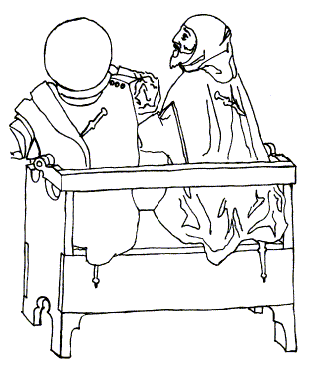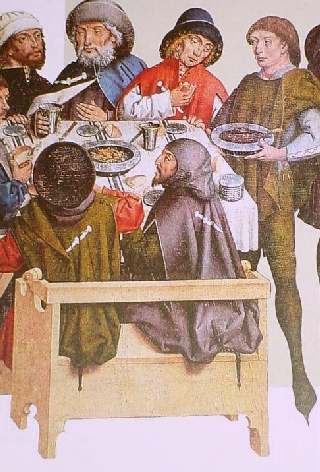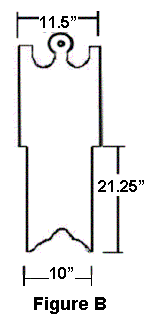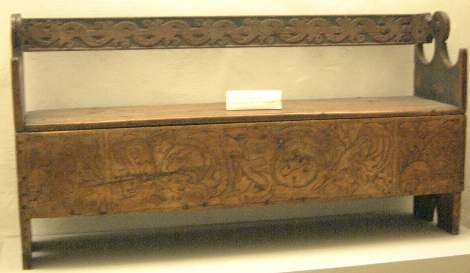 It is all Master Terafan's fault ! I am certain that he has heard this
before. A visit to his website (www.greydragon.org) and you will see why!
It is all Master Terafan's fault ! I am certain that he has heard this
before. A visit to his website (www.greydragon.org) and you will see why!A Simple Bench/Chest Combination
| Syr Raim y Hynnddyl | |
| rayjhindle@windstream.net |
 It is all Master Terafan's fault ! I am certain that he has heard this
before. A visit to his website (www.greydragon.org) and you will see why!
It is all Master Terafan's fault ! I am certain that he has heard this
before. A visit to his website (www.greydragon.org) and you will see why!
Viscountess Gwynna was admiring the Gothic benches and the pair of takedown, transportable boxes I had finished (articles on these and other furniture can be found at Terafan's website).
We were becoming concerned about space inside our pavilion, however, and
transporting everything has necessitated a trailer! "The boxes are great
for storage, but really cannot be used for seating; and the benches are
wonderful seating, but that's all," she said. Feeling those blue eyes
demanding my attention, I looked at her. "I have the  solution right
here," I said, closing the book in my hands with a "pop"! I
passed the volume to her Excellency. "Turn to page 34," I said, as she
opened the book. "A chest that's a bench," she exclaimed, "and it
has a backrest?!" "Yes, comfortable camp seating and storage all
rolled into one neat package," I grinned.
solution right
here," I said, closing the book in my hands with a "pop"! I
passed the volume to her Excellency. "Turn to page 34," I said, as she
opened the book. "A chest that's a bench," she exclaimed, "and it
has a backrest?!" "Yes, comfortable camp seating and storage all
rolled into one neat package," I grinned.
Taken from "What Life Was Like In The Age Of Chivalry" by Time/Life Books, page 34, "A Pilgrimage to Santiago De Compostella". The picture is credited to Archiv Gerstenberg, Wietze, Germany, courtesy Service Archeologique du canton de Berne, Switzerland.
The Bench is assumed to be fifteenth century as the clothing and accoutrements pictured date from that period. A simple "taboret savonarole" (folding chair) is pictured to the left of the bench and is nearly identical to chairs found in numerous 15th C. manuscripts including "The History of Oliver of Castille" and "The Comedies of Terence" (Ms. Latin 664, bibl. De l'Arsenal1, and a piece on exhibit at the Higgins Armory Museum dating from near the turn of the 16th C. The table linen is also consistant with a 15th C. style of Perugia Linen described in Compleat Anachronist # 114, Perugia Towels, by Lady Alianora Munro, page 8.
The Bench is of a simple butt jointed, boarded construction, done here in fir, as would have been used in softwood forested areas of Central and Southern Europe2. Any hardwood may also be used, as determined by the depth of the maker's purse. Oak would most certainly have been used in England, and many of Roger Campin's paintings show settles made of walnut. Pear and other fruitwood would also be strong, durable and historically correct, but we wanted to be able to move the settle when full. The choice is yours!
| Tools Required: Hand Saw Circular Saw or Table Saw Jig or Band Saw Drill 5/8 inch Forstner Bit ¼ inch Bit 1/8 inch Bit Compass Hammer Screwdriver Clamps Sandpaper Steel wool Cabinet Scraper (optional)
|
|
Construction:
|
|
This is a simple six board chest construction with two exception. First, the
front and back (fig. A) must be built up from two 45 inch lengths of 1X12 to
reach the seat height of 22 inches. There are several ways to do this in a
period fashion using dowels, mortise and tenon, or just glue. Secondly, the sides are taller to maintain the pivoting
backrest (fig. B). Note the design at the top of the side panel. The circle is 3
inches in diameter and serves as the pivot for the backrest. The flat topped
uprights on either side support the backrest.
Attach the front and back to the edge of the sides. Your box should measure 45 inches long by 11½ inches wide. Now fashion your top and bottom. The top is a full width 1X12 cut at 43 3/8 inches long attached by the hinges to the back. The bottom is cut 43½ inches long by 10 inches wide, and can be held in place with brackets made from cut waste. Now for the most unique feature of this project: the pivoting backrest!
|
 |
Using the 5/8 inch Forstner bit, drill a hole in the center of the circular appendage at the top of the sides of the box (clamp a piece of scrap to the exit side of the hole to ensure a clean cut). Test fit a short piece of 5/8 inch dowel to each hole. Cut the rails with a 3 inch diameter circle at one end, a 5/8 inch hole centered on the circle, and an overall length of 5¾ inches (Fig. C).
 Fit these over the pivot dowels and mark the uprights that will serve as the
support for the backrest. Cut the backrest 48 3/8 inches
long. Attach the rails to the inside of the backrest as desired (Fig. D). Glue
the pivot dowels into the bench sides NOT the backrest rails. An
attractive touch here is to put a half round wooden cap on the outside of the
pivot dowel. Cut a 1½ inch wooden ball in half,
Fit these over the pivot dowels and mark the uprights that will serve as the
support for the backrest. Cut the backrest 48 3/8 inches
long. Attach the rails to the inside of the backrest as desired (Fig. D). Glue
the pivot dowels into the bench sides NOT the backrest rails. An
attractive touch here is to put a half round wooden cap on the outside of the
pivot dowel. Cut a 1½ inch wooden ball in half, drill it to fit over the pivot
dowel and glue in place.
drill it to fit over the pivot
dowel and glue in place.
After assembly, scrape the entire piece smooth using a cabinet scraper, and lightly sand. I finished with a varnish to give it some protection from the ever changing Meridian humidity and weather. There are a number of references for finishing a piece such as this. Recipes for "varnish" (probably an early version of boiled linseed oil) appear in Cennino d'Andrea Cennini's "Il Libro dell'Arte," and manuscripts of Jehan Le Begue. Some include the addition of a staining element. Even painting is not entirely out of the question. However for a 15th century family, your choices of tempera (egg based) and Milk paint require a top coat to prevent chipping and chalkiness respectively. According to Tom Rettie4, a coat of linseed oil works admirably for this purpose.
 Many
examples of the Flip-Back Settle exist, both as actual pieces of furniture and
represented in countless works of art. They range from the elegantly simple,
like the subject piece, to masterpieces of the cabinet makers art. In each case,
one important point is obvious: this was meant to be indoor furniture. Now, most
of my SCA activity takes place out of doors, and I need furniture with a high
survivability rate.
Many
examples of the Flip-Back Settle exist, both as actual pieces of furniture and
represented in countless works of art. They range from the elegantly simple,
like the subject piece, to masterpieces of the cabinet makers art. In each case,
one important point is obvious: this was meant to be indoor furniture. Now, most
of my SCA activity takes place out of doors, and I need furniture with a high
survivability rate.
Since this is to be used indoors and out, I made some practical concessions and used Gorilla Glue at all the joints and glue points. I also finished it with a spar varnish to give it some protection from the ever changing Meridian humidity and weather.
As for fasteners, screws did exist in the late Middle Ages. Handmade, with square tips and rounded heads³ they are very similar to antique gunstock screws Although this piece would hardly have rated such an extravagance, I have used screws on the hinges, and in the butt joints as this piece will be used in camp and possibly uneven terrain. Countersinking the screws at the joints and filling the holes with dowels gives a pleasing look. Most often clinch nails would have been used, but these must be handmade or purchased at an expense much greater than the modern screws I used.
Notes
¹ Howe, John, Dragon #4, The Voice of the Company of Saint George,Le
Mobilier (Author's translation). May 1992. Page 11.
² Salzman, L.F. Building in England Down to 1540. Oxford University Press,
Oxford, 1952 (Special Edition for Sandpiper Books Ltd., 1997). Page 250.
³ Aricola, Gregorius. De Re Metallica. (Hoover, Herbert Clark and Hoover, Lou
Henry, translators.) Dover Publications, Inc., New York, 1950. Page 364
4 Rettie, Tom. www.bloodandsawdust.com/Blood_and_Sawdust/Blood_and_Sawdust_Home_Page.html,
Tom Rettie's Home Page. A compendium of knowledge and wisdom concerning Medieval
furniture and woodworking in period. The FAQ section is particularly helpful as
is the Recommended Reading section. He is known in the Society as Master
Findlaech mac Alasdair, OL, CP, CGD, QOC, etc.
Lastly, my sincere thanks to Peter Barclay, ska Master Terafan Greydragon, without whose inspiration, this project would never have been undertaken, and whose wonderful photos adorn these humble pages.
©2003, Raymond J. Hindle. May be used and distributed freely for personal use, provided proper credit is given, and no payment is sought or made. Please contact the author at rayjhindle@windstream.net concerning publication.